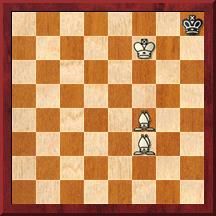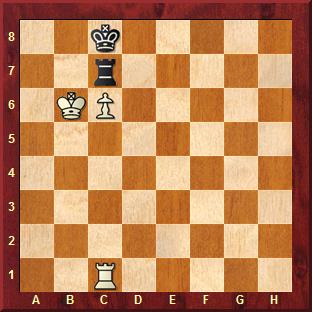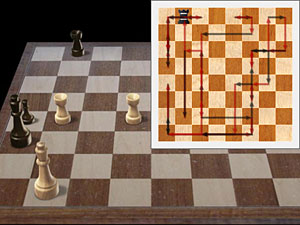Stalemate: the long and the Short of it – part 2
By H. Paul Lillebo
In the first part of this article I discussed the idea of GM Nigel Short and others that stalemate should be scored not as a draw, but as a win for the stalemating player. My own reaction to that proposal remains negative. In my view, the possibility of stalemate adds a valuable dimension to chess. It requires the stronger side to conduct the attack with care, and to pay attention to subtleties in the position and unexpected resources for the defense. Above all, it leads to complex theory in end game play, where without the stalemate draw the game would be mechanical.
A final hurdle
To take a simple example, the first diagram below shows a typical two bishop mating pattern. The black king is corralled in the h8 corner. An alert player with white will have no difficulty: he needs only play a waiting move, say 1.Be3, and after 1…Kh7 finish the job with 2.Be4+ and 3.Bd4++. But a player sleep-walking through this “obvious” win might be so eager to finish as to play 1.Be4 right away. It’s a blunder, of course: you’ve stalemated the opponent and given away the win.



Next are two similar embarrassments that inexperienced players regularly fall into: in the second diagram White has just played Qe1-e6, expecting to mate on his next move. Of course there will be no next move, because the game has now ended in stalemate. White had a myriad of reasonable moves (including the best, Kc6, forcing mate in one), but has blundered into a draw.
Similarly, in the third diagram Black has moved his king to the corner after a knight check, and White has eagerly brought his rook into the action with Ra2-a7, threatening the typical mate on h7. But that mate won’t happen, because the game has just ended in stalemate.
Those who agree with GM Short feel that coming close is good enough: Checkmate is no longer necessary, and players shouldn’t have to learn the subtleties needed to get over such hurdles as the above. We shouldn’t be allowed to blunder away a win; we deserve somehow to be protected against our own blunders! In society we have laws to protect us from ourselves, such seat-belt laws, but in most cases these are justified as protecting others. But the proposed anti-blunder rule has no such redeeming social value. It would solely protect the blunderer against his own oversights: it should no longer be possible to mess up the above endings.
Swindles
Every language has proverbs that caution a buyer against getting swindled: “Don’t buy a pig in a poke” (i.e., in a sack, unseen). In “real life” swindling isn’t nice. But chess is war, and swindling is more or less what it’s all about. If you get swindled, it’s your own fault; you missed something you should have seen. The stalemate swindle is often the last resource of the player who is at the end of his rope. Nothing recommends the stalemate rule more than the opportunity for swindling that it affords a defender, requiring the attacker to be ever alert. Chess history is full of such happy events (in the defender’s view). One example comes from Bird-Englisch, London 1883.

[Event "London+"] [Site "London"] [Date "1883.??.??"] [Round "?"] [White "Bird, Henry Edward"] [Black "Englisch, Berthold"] [Result "1/2-1/2"] [ECO "C54"] [PlyCount "87"] [EventDate "1883.??.??"] [EventType "tourn"] [EventRounds "26"] [EventCountry "ENG"] [Source "ChessBase"] [SourceDate "1999.07.01"] 1. e4 e5 2. Nf3 Nc6 3. Bc4 Bc5 4. c3 Nf6 5. b4 Bb6 6. d3 d6 7. O-O O-O 8. Bg5 Be6 9. Nbd2 Qe7 10. a4 a6 11. a5 Ba7 12. Kh1 h6 13. Bh4 Rad8 14. b5 Bxc4 15. Nxc4 axb5 16. Ne3 Bxe3 17. fxe3 Qe6 18. Qb1 g5 19. Bg3 Na7 20. c4 c6 21. c5 Nh5 22. a6 bxa6 23. Rxa6 Qd7 24. d4 Nxg3+ 25. hxg3 Nc8 26. cxd6 f6 27. Rc1 Nxd6 28. Rcxc6 Ne8 29. Qxb5 g4 30. Nh4 exd4 31. exd4 Qxd4 32. Nf5 Qxe4 33. Re6 Rd1+ 34. Kh2 Qb1 35. Qxb1 Rxb1 36. Ra7 Rb5 37. Nxh6+ Kh8 38. Nxg4 Rg5 {[#]In this position White tried to win quickly with} 39. Rxe8 {But Black inserted} Rh5+ $1 ({White was perhaps hoping for} 39... Rxe8 40. Nxf6 {with a win.}) {and after} 40. Kg1 Rxe8 41. Nxf6 {Black surprised White with} Rh1+ $1 42. Kxh1 (42. Kf2 { would lose to} Rf8) 42... Re1+ 43. Kh2 Rh1+ {forcing his own stalemate. A beautiful and surprising resource, made possible, as usual, by an error (39. Rxe8) on the part of the attacker.} 44. Kxh1 1/2-1/2
The next example is a great swindle from an amateur blitz game, where White sacs his entire remaining army.

[Event "?"] [Site "?"] [Date "2014.08.19"] [Round "?"] [White "Amateur blitz game"] [Black "?"] [Result "1/2-1/2"] [SetUp "1"] [FEN "6k1/3R1p2/4p1p1/p2n2Qp/2p1q3/8/5P1K/r7 w - - 0 1"] [PlyCount "14"] {White, who is completely lost, invites Black to blunder with} 1. f3 $1 {(his only hope).} {Black sees the chance for great things on h1, and plays} Qxf3 $4 2. Rd8+ (2. Qxg6+ fxg6 3. Rd8+ Qf8) 2... Kg7 3. Rg8+ Kh7 (3... Kxg8 4. Qxg6+ Kf8 5. Qg8+ Ke7 6. Qd8+ Kxd8) 4. Rg7+ Kxg7 5. Qxg6+ Kf8 6. Qg8+ Ke7 7. Qd8+ Kxd8 {stalemate. Of course, the stalemate=win camp feels that Black should be given win here anyway. Grotesque idea!} 1/2-1/2
The following swindle is a useful bit of rook end game theory.

White to move wins easily: 1.Ra1 Kb8 2.Ra8+, but Black to move can draw with 1…Kb8!. After 2.Rh1 Rb7+! 3.Kc5 (3.cxb7 is stalemate) Rb2, Black has achieved the Philidor drawing line.
The king chase
A common stalemate involves chasing the king around with a rook, trying to give it away. A classic example of this theme comes from the following game:

[Event "Barmen Masters-B"] [Site "Barmen"] [Date "1905.08.22"] [Round "8"] [White "Post, Ehrhardt"] [Black "Nimzowitsch, Aaron"] [Result "1/2-1/2"] [ECO "D07"] [PlyCount "196"] [EventDate "1905.08.14"] [EventType "tourn"] [EventRounds "17"] [EventCountry "GER"] [Source "ChessBase"] [SourceDate "1999.07.01"] 1. d4 d5 2. Nf3 Bg4 3. c4 Nc6 4. cxd5 Bxf3 5. gxf3 Qxd5 6. e3 e5 7. Nc3 Bb4 8. Bd2 Qd7 9. d5 Nce7 10. Qb3 Bxc3 11. Bxc3 Qxd5 12. Qxd5 Nxd5 13. Bxe5 f6 14. Bd4 Nge7 15. Rg1 O-O 16. Bc4 Kh8 17. Bc5 Rfe8 18. O-O-O Nb6 19. Bf7 Rf8 20. Bh5 g6 21. Bxe7 Rf7 22. Bxg6 hxg6 23. Bb4 Kg7 24. Rd4 c5 25. Bxc5 Rc8 26. b4 Nd7 27. Kb1 Nxc5 28. bxc5 Rxc5 {All the pieces except for the four rooks are off the board; White holds a 5-4 pawn advantage.} 29. Rdg4 Rb5+ 30. Ka1 g5 31. h4 Rc7 32. hxg5 Rc2 33. gxf6+ Kf7 34. Rb1 Ra5 35. Rxb7+ Kxf6 36. Rf4+ Ke6 37. a4 Rxf2 38. Rb2 Rf1+ 39. Ka2 Re5 40. Re2 Kd5 41. Kb2 Kc5 42. Kc3 Rc1+ 43. Kd2 Ra1 44. Rg4 Rf5 45. Rf2 Re5 46. e4 Kd4 47. Rg7 Ra2+ 48. Ke1 Rxa4 49. Re2 Rh5 50. Rd7+ Kc4 51. Rc2+ Kb3 52. Rcd2 Ra1+ 53. Ke2 a5 54. Rb7+ Kc3 55. Rc7+ Kb3 56. Kd3 Rf1 57. Rb7+ Ka3 58. Ke3 a4 59. Kf4 Rh4+ 60. Kg5 {The pawns are now reduced to 2:1. Nimzowitch assessed that his position would be lost, were it not for stalemate possibilities. He sac's a rook with} Rxf3 {and the fun begins. After} 61. Kxh4 Rf4+ 62. Kg3 {Black plays} Rf3+ {This started a king hunt by the black rook lasting 37 moves, where the rook offered itself to the white king and to each of the white rooks no less than 28 times.} 63. Kg4 ({If the king takes the rook, it's stalemate:} 63. Kxf3) 63... Rf4+ 64. Kg5 Rf5+ 65. Kg6 Rf6+ 66. Kg7 Rg6+ 67. Kh8 Rg8+ 68. Kh7 Rh8+ 69. Kg6 Rh6+ 70. Kf5 Rf6+ 71. Kg5 Rf5+ 72. Kg6 Rf6+ 73. Kg7 Rg6+ 74. Kh8 Rg8+ 75. Kh7 Rh8+ 76. Kg6 Rh6+ 77. Kg5 Rg6+ 78. Kf4 Rg4+ 79. Kf3 Rf4+ 80. Ke2 Rxe4+ 81. Kd1 Re1+ 82. Kc2 Rc1+ 83. Kd3 Rc3+ 84. Kd4 Rc4+ 85. Kd5 Rc5+ 86. Kd6 Rc6+ 87. Kd7 Rb6 88. Rc7 Rb2 89. Rd4 Rb8 90. Rcc4 Ra8 91. Rb4 Ra6 92. Ke7 Ra7+ 93. Ke6 Ra6+ 94. Ke5 Ra5+ 95. Ke4 Ra6 $2 { unfortunately this leads to a forced win for White.} 96. Kd3 Ra8 97. Kc2 Rc8+ 98. Kb1 $2 (98. Rbc4 {is mate in five.}) 98... Rb8 {and a draw was agreed, since all white moves lead either to stalemate or other dead draws.} 1/2-1/2
– Part three to follow soon –




























